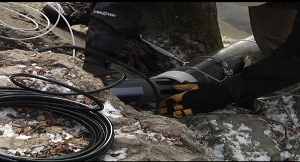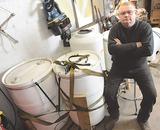Sensors to Assess Water Quality
http://www.azosensors.com/Details.asp?newsID=1726
Sensors to Assess Water Quality
In order to determine the condition of drinking water due to horizontal gas drilling,  a pre-drilling water examination will be carried out for identifying the variation in water quality before and after the drilling process, with respect to the statements of the residents of Pennsylvania.
a pre-drilling water examination will be carried out for identifying the variation in water quality before and after the drilling process, with respect to the statements of the residents of Pennsylvania.
Various sensors will be employed for executing these tests. Ten of the sensors will be integrated along the branches of the Southern Tier Susquehanna River, for monitoring the quality of the water.
According to Kimberly Dille, of the Susquehanna River Basin Commission, the sensors will be monitoring the conductivity, dissolved oxygen, temperature, pH and the turbidity conditions of the water. He remarked that, the quality will be assessed every five minutes and upon the progression of horizontal gas drilling in New York, the Susquehanna River Basin Commission will be measuring the status of water irrespective of time, to avoid the contamination of water.
Andrew Gavin, of SRBC, commented that, when sensing any change in the normal water quality, a warning will be given to their office, providing rapid alertness to the officials about the condition. The SRBC has been collaborating with the Tioga County Planning Department for detecting areas to install these sensing devices on the Apalachin and Catatonk Creeks. According to Elaine Jardine, Director of Tioga, Planning and detecting the quality of water prior to the drilling process, while drilling and after the drilling process is highly significant for knowing the safety of the drinking water.
The SRBC will be integrating ten sensors in New York and has already installed thirty in Pennsylvania. After the establishment of a monitoring station, anyone can assess the status of water through SRBC.net.
Fracking expert to speak at LCCC
http://citizensvoice.com/news/drilling/fracking-expert-to-speak-at-lccc-1.1076898
Fracking expert to speak at LCCC
Published: December 14, 2010
The Gas Drilling Awareness Coalition is sponsoring a presentation by Cornell University professor Dr. A. R. Ingraffea, “Unconventional Gas Plays: Information for an Informed Citizenry,” at 7 p.m. Thursday in Room 132 of Luzerne County Community College’s Educational Conference Center.
Ingraffea, an expert on hydraulic fracturing, is the Dwight C. Baum professor of Engineering and Weiss Presidential fellow at Cornell University’s School of Civil and Environmental Engineering.
Ingraffea has won numerous awards, done research and development for organizations including the National Aeronautics and Space Administration, the Gas Research Institute, the U.S. Department of Transportation and several private companies, and is on the candidate list for the U.S. Environmental Protection Agency’s Science Advisory Board for the Review of Hydraulic Fracturing Study.
For more information, call 570-266-5116, visit www.gdacoalition.org or e-mail gdacoaltion@gmail.com.
A primer on Marcellus Shale geology and technology offered in webinar
http://live.psu.edu/story/50263#nw69
Monday, December 6, 2010
A primer on Marcellus Shale geology and technology offered in webinar
 University Park, Pa. — By now, many are aware of the huge volume of natural gas held in the deeply buried Marcellus Shale formation and its enormous economic potential for Pennsylvania and neighboring states.
University Park, Pa. — By now, many are aware of the huge volume of natural gas held in the deeply buried Marcellus Shale formation and its enormous economic potential for Pennsylvania and neighboring states.
For those who want to learn more about the Marcellus “play,” Penn State Cooperative Extension is offering a free, Web-based seminar at 1 p.m. on Dec. 16, titled, “Plumbing the Depths in Pa.: A Primer on Marcellus Shale Geology and Technology.”
During the one-hour webinar, Michael Arthur, professor of geosciences, will focus on the geology of the Marcellus Shale and technology for extraction as they influence exploration and development of the natural-gas resource. Co-director of the Penn State Marcellus Center for Outreach and Research, Arthur will answer questions from online participants during the session.
“The middle Devonian Marcellus Formation in the Appalachian Basin of Pennsylvania and New York is estimated to contain in excess of 486 trillion cubic feet of extractable natural gas,” he said. “That is sufficient for more than 20 years supply at the United States’ current rate of consumption.”
Arthur pointed out that there also is the possibility of additional significant shale gas deposits that may be targeted within the same basin — Devonian black shale units above the Marcellus Shale and the Ordovician Utica Shale below.
“In my presentation, I will discuss the geologic characteristics of the Marcellus Shale formation, the estimated volume of gas deposits at various points, and the process and effect of hydraulic fracturing,” Arthur said. “I also will address the continuing concern that drilling operations could allow gas migration into shallow, fresh-water aquifers, which is now being studied intensively.”
The webinar, “Plumbing the Depths in Pa.: A Primer on Marcellus Shale Geology and Technology,” is part of an ongoing series of workshops and events addressing issues related to the state’s Marcellus Shale gas boom. Information about how to register for the webinar is available on the webinar page of Penn State Cooperative Extension’s “Natural Gas” website. .
Additional one-hour webinars will be held at 1 p.m. on the following dates:
— Jan. 20, 2011: “Marcellus Shale Legislation: What Was Accomplished in the 2009-10 Session and What Issues Remain to be Addressed.”
— Feb. 16, 2011: “Dealing with Gas Tax Issues: What You Need to Know.”
— March 17, 2011: “Natural Gas Well Development and Emergency Response and Management.”
Previous webinars, publications and other information on topics such as water use and quality, zoning, gas-leasing considerations for landowners and implications for local communities also are available on the “Natural Gas” website at http://extension.psu.edu/naturalgas.
For more information, contact John Turack, extension educator in Westmoreland County, at 724-837-1402 or by e-mail at jdt15@psu.edu.
Fracking: New drilling method prompts concerns
http://tribune-democrat.com/local/x1531215899/Fracking-New-drilling-method-prompts-concerns
December 13, 2010
Fracking: New drilling method prompts concerns
By Kathy Mellott kmellott@tribdem.com
 John Slesinger of Elton stands next to drums of water he keeps in his basement after he says his well was contaminated by a nearby drilling operation.
John Slesinger of Elton stands next to drums of water he keeps in his basement after he says his well was contaminated by a nearby drilling operation.
JOHNSTOWN — Mention Marcellus Shale natural gas drilling and the subject of “fracking” quickly follows.
Fracking – hydraulic fracturing – is the process used to crack open the deep, dense shale bed that lies more than a mile below earth’s surface.
Estimates are that the Marcellus abundance is so great that Pennsylvania likely will have as many as 100,000 wells in years to come, changing the landscape dramatically.
Knowledge of the gas in the shale bed is not new, but the technology to go after it is new.
Drilling companies are now capable of drilling straight down into the Marcellus Shale, and then outward at an angle into the slanted shale bed.
Fracking involves pumping large volumes of water and sand into a drilled area to break the shale fissures to push out the gas that lies between them.
Geologists, hydrobiologists and the gas industry say fracking has been around for 60 years, not only in the oil-rich Southwest, but in the Northeast.
Fracking has been used safely and efficiently across the U.S. for more than 60 years, and in Pennsylvania since shortly after World War II, according to the Pennsylvania Independent Oil & Gas Association, which wrote: “The goal of the fracking process is to create a pathway of man-made cracks in the rock that allow gas to flow from the shale into the well bore.”
Improved technology allowed for a greater water volume and changes in chemical additives used in the process. That opened the door for the deep shale gases to be reached more economically, said hydrogeologist David Yoxtheimer of Penn State’s Marcellus Center for Outreach and Research.
A bendable well casing is turned horizonally about 500 feet above the Marcellus bed.
The fracking is done through lateral drillings that are 2,000 to 7,000 feet long – opening up a natural gas drainage area.
One well pad with four or more wells can drain the natural gas from a square mile, said Michael Arthur, a geologist and MCOR co-director.
Research being done at Penn State may lead to the use of carbon dioxide and propane in the fracking process. But water continues to be the most common means, Yoxtheimer said.
‘Most previous resource’
The magnitude of the drilling/fracking process, the large volumes of water needed and the potential release of chemicals into nearby waterways concerns many people, including environmentalists.
A recent Tribune-Democrat Web poll of 2,034 readers showed that 1,226, or 60 percent, were concerned about the risks of fracking. A total of 478, or 24 precent, thought the process is safe, while 329, or 16 percent, indicated they have no knowledge of the fracking process.
Ralph Kimber, a Williams-port resident and a member of Responsible Drilling Alliance of Lycoming County, fears there is much that may be learned after the wells are already installed and operational.
“Water will be the most precious resource in the world by the end of this century,” Kimber said.
Others think the concerns are exaggerated.
The Ground Water Protection Council, a national group whose mission is to safeguard water sources, stated in a 2009 report that the potential for groundwater contamination due to hydraulic fracturing is remote.
A huge concern is the potential for human error and carelessness.
The state Department of Environmental Protection reported late last week that it had fined RN Industries Trucking Inc. $3,000 for allegedly storing drilling wastewater in five tanks at a site in Clearfield County.
An April inspection revealed that there were 1,950 barrels, or about 82,000 gallons, of the wastewater on the site in Sandy Township. No spillage or ground contamination was reported, said Dan Spadoni of DEP’s regional office in Williamsport.
A May follow-up inspection showed the site was no longer being used for storage and the wastewater had been removed.
The fine money was put into the state’s Solid Waste Abatement Fund to help pay for environmental cleanups statewide, Spadoni said.
‘Minimum of chemicals’
A concern echoed across the state is the large amount of water that fracking requires – usually between 3 million and 5 million gallons per well, with some well pads hosting six to eight wells.
The water sources vary, but much of the fracking water in Pennsylvania comes from groundwater sources – including local streams and rivers – or is purchased from municipal water companies.
While an increasing number of drilling companies are building pipelines to move water to well sites, much water continues to be transported in tanker trucks.
Water makes up 95 percent of the fracking mix, with sand accounting for 4.5 percent. The rest is comprised of small amounts of various compounds – hydrochloric acid, friction reducers and corrosive inhibitors, Yoxtheimer said.
The solution is mixed at the well site before high pressure injection.
An estimated 70 chemicals can be used in the fracturing process, but most drillers use very few, sometimes only three or four.
“On any given frack job, they’re using a minimum of chemicals,” Yoxtheimer said.
The fracking begins with a “charge” – a big bullet of lead or metal sent into the well. The force punctures through the shale. The water, sand and chemicals are then pumped in, Yoxtheimer said.
Engineers with Chief Gas and Oil call the puncturing device a “perf gun,” which is inserted into the drilled well. The gun uses an electrical current to set off small gunpowder-filled caps to create holes in the shale.
The sand holds the fractures open, allowing the natural gas to escape up the well. The chemicals are needed to allow the process to happen, Yoxtheimer said.
For example, he said, a surfactant reduces surface tension of the water; potassium chloride reduces friction; hydrochloric acid cleans out any cement and prevents clogging.
The industry is striving to reduce the number of chemicals, Yoxtheimer said.
Chief – which has a number of wells in the Cambria-Somerset region – has made progress, said Kristi Gittins, vice president of public affairs.
“We’ve been doing this for 12 years, and we use fewer chemicals now than we ever have,” Gittins said.
DEP’s new Marcellus well and drilling regulations require gas companies to disclose the chemicals used in a well.
‘A lot more stuff’
The fracking is done in an area of geology formed 400 million years ago, an area which once served as ocean floor and today has salt levels 10 times that of sea water, geologists say.
The bulk of the water used for fracking remains in the ground.
Currently, the most troubling part of the process for many is the estimated 10 percent to 15 percent of the frack water that comes back out of the pressurized well. Sometimes the amount can be as high as 20 percent. The back-flow contains some of the chemicals sent down the well, which then have mixed with salty solutions that have formed over hundreds of millions of years.
Frack back-flow has historically been hauled from well sites for processing at approved treatment plants.
But as state regulations have been tightened concerning where and how the water is to be treated. That has, in turn, increased the numbers of drillers who are recycling the water or treating it on-site for reuse, Yoxtheimer said.
The Marcellus formation is relatively dry and has the ability to absorb the 80 percent to 90 percent of the water, sand and chemical solution that remains in the well after the fracturing, Yoxtheimer said.
“Ideally there wouldn’t be any interaction or noticeable disturbance,” he said.
Dennis Beck, chairman of the Cambria County Conservation District’s Water Resources and Watershed Development Committee, sees the potential for big problems.
Beck, who also is a member of the Portage Water Authority, would like to see clearer identification on tanker trucks used when the frack water overflow is taken from a well site.
Generally, signage says the tankers are carrying “brine and residual waste.”
“There is a lot more stuff in there than salty water,” he said.
If a tanker comes around the north of Blue Knob and flips over on the Route 164 hairpin curve at the reservoir, significant problems could result, Beck said.
“The firemen will look at that placard and think it’s just brine and wash it off the highway into the reservoir,” Beck said.
Putting the Brakes on Natural Gas Fracking
December 13, 2010
Putting the Brakes on Natural Gas Fracking
Fracking, the process of blasting deep rock strata to release methane that can then be pumped to the surface and sold as natural gas, is one of the ugliest innovations the energy industry has come up with. And unlike the ugliness of the Alberta Tar Sands, fracking takes place in pristine rural farmlands of the Appalachian Mountain region, such as Pennsylvania and West Virginia.
Big frack attack: Is hydraulic fracturing safe?
This is an excellent article covering all aspects or hydraulic fracturing.
In the 1953 Looney Tunes cartoon “Much Ado About Nutting,” a frustrated squirrel hauls a coconut around New York City, aware it’s a feast but unable to crack it open. It’s reminiscent of an even trickier and more tantalizing jackpot that had, until recently, eluded the United States for nearly two centuries: shale gas, the hard-shelled dark horse of fossil fuels.
That squirrel never tasted the fruits of his labor, however, while the U.S. started figuring out shale gas by the late 1990s and early 2000s, after nibbling at it since the 1820s. But as shale fever sweeps the country — courtesy of a gas-drilling trick called hydraulic fracturing, aka “fracking” — some Americans have begun to wonder if, like the squirrel, we might be hurting ourselves as much as the protective husk around our prize.
DRAFT NATURAL GAS DEVELOPMENT REGULATIONS
From the Delaware River Basin Commission’s Web Site
http://www.state.nj.us/drbc/
DRAFT NATURAL GAS DEVELOPMENT REGULATIONS
posted December 9, 2010
Written comments accepted through 5 p.m. March 16, 2011. Three public hearings will be scheduled; details will be released as soon as they are confirmed.
Please note that this public rulemaking process must be completed prior to the Commissioners taking any action on the proposed regulations. Such action will be taken at a duly noticed public meeting of the Commission at a future date.
http://www.state.nj.us/drbc/notice_naturalgas-draftregs.htm
Water agency to publish gas drilling regulations
http://online.wsj.com/article/AP01539f691bec4cc08103242571a7f2e2.html
DECEMBER 9, 2010
Water agency to publish gas drilling regulations
WEST TRENTON, N.J. — The agency that oversees water quality and quantity in the Delaware River basin says it has finished work on proposed regulations for the natural gas drilling industry.
The Delaware River Basin Commission announced Wednesday that draft regulations will be available for public review beginning at 9 a.m. Thursday.
The commission has declared a moratorium on Marcellus Shale drilling projects in the Delaware River basin until the rulemaking process is complete. The panel has jurisdiction because the drilling process will require the withdrawal of huge amounts of water from the watershed’s streams and rivers. The commission has also cited the potential for groundwater and surface water contamination.
Drilling is in full swing elsewhere in Pennsylvania.
The DRBC is a compact agency representing the federal government and the states of Delaware, New York, New Jersey and Pennsylvania.
Monitoring River Water
http://www.wbng.com/news/local/Monitoring-River-Water-111551409.html
Monitoring River Water
By WBNG News
December 8, 2010
Apalachin, NY (WBNG Binghamton) When some Pennsylvania residents began to claim that horizontal gas drilling contaminated drinking water, many were asked to provide a pre-drilling water test to show the difference. River water will now undergo a similar test.
Ten of these monitoring sensors will be installed along tributaries to the Susquehanna River in the Southern Tier. They will measure basic information about water quality.
That includes “temperature, conductivity, dissolved oxygen, turbidity, pH,” said Kimberly Dille with the Susquehanna River Basin Commission. “We’re measuring at a five-minute interval.”
If and when horizontal gas drilling moves forward in New York, the Susquehanna River Basin Commission wants to know the condition of the water ahead of time, in case an accident contaminates the water.
“If any deviations would occur that would depart from normal ranges, an alert is sent to our office where staff would immediately know if there was a change of condition,” said the SRBC’s Andrew Gavin.
“There are certain conditions in local streams that might even be natural for an area,” said Susan Obleski of the SRBC. “If people see spikes in certain chemicals they may not realize that that tends to happen naturally certain times of the year.”
The SRBC has been working with the Tioga County Planning Department on finding locations for sensors on the Apalachin and Catatonk Creeks.
“We’ve always know that monitoring water quality — both getting a baseline before drilling, during drilling and after drilling was very important to our drinking water,” said Elaine Jardine, Tioga Co. Planning Director.
The SRBC will install ten monitors in New York. It already has thirty in Pennsylvania.
After a monitoring station is installed, anyone can check water conditions at SRBC.net.
Publication addresses water withdrawals for Marcellus gas drilling
http://live.psu.edu/story/50172#nw69
Wednesday, December 1, 2010
Publication addresses water withdrawals for Marcellus gas drilling
University Park, Pa. — Penn State Cooperative Extension < http://extension.psu.edu/ > has released an updated version of a publication that addresses the rapidly changing topic of water withdrawals for Marcellus Shale gas drilling.
Originally published in September 2009, “Water Withdrawals for Development of Marcellus Shale Gas in Pennsylvania” reflects the latest Marcellus-related regulatory changes enacted by the Susquehanna River Basin Commission, the Delaware River Basin Commission and the Pennsylvania Department of Environmental Protection.
Water is a critical component in the process of extracting natural gas from the Marcellus Shale formation. Public policies for managing and protecting water resources are common concerns of Pennsylvania residents, according to a water-policy expert in Penn State’s College of Agricultural Sciences. < http://agsci.psu.edu/ >
“Development of the Marcellus Shale could have major economic and environmental effects for Pennsylvanians and residents of neighboring states,” said Charles Abdalla, professor of agricultural and environmental economics. “Individuals, businesses and communities will be affected well into the future as this energy resource is fully developed.
“Citizens need to become aware of their stake in water-resource issues and policies and effectively participate in public policy-making,” he said. “Public policies for water management and protection will be improved if the affected parties — which include almost everyone — are well-informed about likely impacts and take advantage of opportunities to participate in decisions.”
Seeking to engage residents, landowners, federal and state agency personnel, environmental organizations, economic development groups and others, the publication discusses the fast-evolving issues and public policies related to water resources and Marcellus Shale gas exploration.
While adequate supplies of water are one of several essential inputs needed to extract gas from the shale, wastewater is an output from the process that must be treated or disposed of properly.
“Through this publication, we hope to increase the public’s understanding of water use and management related to Marcellus Shale gas development and help people understand how and where they can offer input into public decisions about water use and wastewater treatment,” said Abdalla, the publication’s lead author.
“Now is the time for people to learn about and help shape public policies that will guide development of the Marcellus Shale,” he said. “These policies will play a large part in determining the economic well-being and quality of life for residents of the commonwealth for a long time — perhaps generations — to come.”
Funding for the updated publication comes from the Pennsylvania Water Resources Research Center
< http://www.pawatercenter.psu.edu/ > at Penn State. To obtain a free copy, contact the Penn State College of Agricultural Sciences Publication Distribution Center < http://pubs.cas.psu.edu/ >, The Pennsylvania State University, 112 Agricultural Administration Building, University Park, PA 16802-2602; telephone: 814-865-6713; fax: 814-863-5560; or send an e-mail to AgPubsDist@psu.edu.
This publication also is available online in PDF format. < http://extension.psu.edu/water/resources/publications/consumption-and-usage/marcelluswater.pdf/view >
The publication is the latest in a series initiated by Penn State’s College of Agricultural Sciences and Penn State Cooperative Extension to address issues related to Marcellus Shale gas exploration and development. Other publications in the series, along with related webinars, presentations and events, can be viewed at Cooperative Extension’s “Natural Gas” website. < http://extension.psu.edu/naturalgas >


